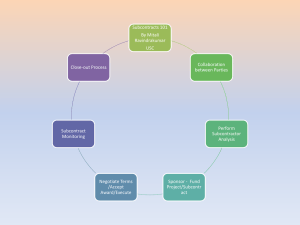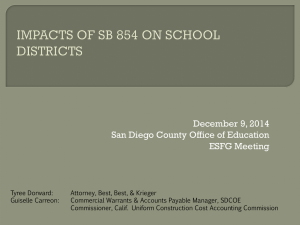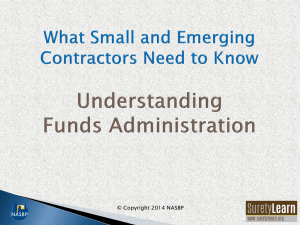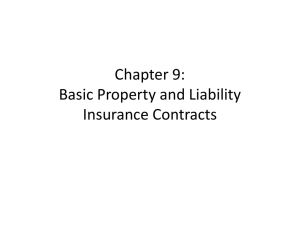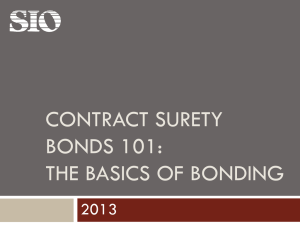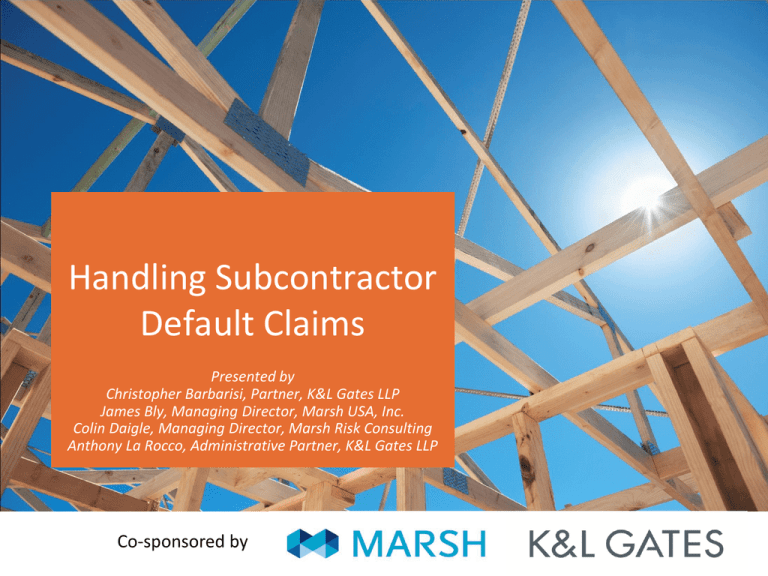
Handling Subcontractor
Default Claims
Presented by
Christopher Barbarisi, Partner, K&L Gates LLP
James Bly, Managing Director, Marsh USA, Inc.
Colin Daigle, Managing
Director,by
Marsh Risk Consulting
Presented
Anthony La Rocco, Administrative Partner, K&L Gates LLP
Co-sponsored by
SUBGUARD CLAIM PREPARATION
1
Subguard Claim Preparation
Pre-Claim Considerations
Contract type and contract administration.
Project governance.
Scope.
General conditions.
Schedule.
Documentation.
Claims team.
2
Subguard Claim Preparation
A Default Occurs – Initial Focus (Continued)
Identify pitfalls affecting overall completion, issues with the owner,
entitlement and proof around default, etc.
Stay ahead of the default impacts.
Develop a claim strategy to maximize recovery and expedite processing.
Align project controls with claim prep.
Be proactive — engage all relevant parties.
Timing of payments typically becomes a frictional area with complex claims.
3
Subguard Claim Preparation
The Proof of Loss - Overview
Simple calculation: difficultly tends to be more on establishing a
reasonable level of documentation.
Draws a line in the sand at default.
Reconciles the amount of the subcontract dollars available.
Applies those dollars to completion costs.
Overrun is the claim.
4
Subguard Claim Preparation
The Proof of Loss – Example Calculation
PROOF OF LOSS SUMMARY
ADDITIONAL COMPLETION COSTS
P R E - D E FA U LT
CATEGORY
P O S T- D E FA U LT
AMOUNT
CATEGORY
AMOUNT
Labor Costs
$ 1,000,000
Material Costs
$ 1,500,000
Original Subcontract Amount
$
15,000,000
Changes to Scope/Change Orders
$
1,000,000
Revised Subcontract Value
$
16,000,000
Equipment and/or Tool Costs
$
Amount Paid to Sub
$
13,000,000
Subcontractor's Costs
$ 4,500,000
Legal/Consulting
$
500,000
Unpaid Vendors
$
300,000
Indirects
$ 1,500,000
Total Costs Incurred
$ 9,800,000
Subcontract Balance
TOTAL CLAIM AMOUNT
$
3,000,000
$
500,000
6,800,000
5
Subguard Claim Preparation
“Contemporaneous” Claim Documentation
Contract/subcontract.
Job cost reports.
Change order log.
Original budget/estimates.
Drawings/submittals.
Vendor invoices.
Time cards.
Payroll reports.
Daily reports.
Baseline and all update schedules.
Project photographs.
Correspondence/emails.
6
Subguard Claim Preparation
Managing the Claim Process
Multiple submissions — put some thought into cut-off dates and Proof of
Loss amounts.
Consider time to review and process for responding.
Requests for Information (RFIs).
What to expect and how to manage them.
Qualitative tracking of the process.
Contractor should keep a record of information provided and the number of times a
question is asked.
Engage the insurer’s consultants to expedite.
Dedicate resources.
7
PRODUCTS TO MITIGATE SUBCONTRACTOR
DEFAULT RISK
8
Products to Mitigate Subcontractor Default Risk
Subcontractor Default Insurance
Surety bond vs. Subcontractor Default Insurance (SDI):
Tri-party relationship between surety, bond principal, and bond obligee.
Surety’s right of indemnification from bond principal.
Surety stands in the shoes of subcontractor.
Potential for multiple lawsuits.
Negotiate subcontractor bond language — dispute resolution, surety’s time to respond
recoverable damages, attorney’s fees.
Performance bond claims — may require subcontract termination to trigger surety’s
performance unless surety chooses to finance defaulted subcontractor.
Termination — drastic measure that increases risk for all parties.
9
Products to Mitigate Subcontractor Default Risk
Subguard® = The First SDI Policy Written by Zurich in 1996
What is Subguard®?
Definition
Subguard® is a first-party insurance policy that indemnifies the insured for costs
incurred as a result of a default of performance by one of its subcontractors.
GC/CM
(Obligee)
GC/CM
Subcontractor
(Principal)
Surety
Subcontractor
10
Products to Mitigate Subcontractor Default Risk
Default Protection and Risk Transfer
Subguard®:
Insurance product that protects contractor from subcontractor’s default:
Insurance company pays for “paid project losses.”
Losses must be first paid by the GC — Subguard® will not front the loss.
Proof of loss — covered costs, procedure, and timing.
Direct and indirect losses/costs:
Delay, impact, attorney/consultant fees.
Separate limits of coverage.
Exclusions.
Deductible.
Subrogation recovery against subcontractor.
Subguard® and contractor vs. defaulted subcontractor.
Subguard®/Insurer — right of recovery against contractor for Subguard® payments in
event of wrongful default.
11
Products to Mitigate Subcontractor Default Risk
A Second Market — Arch
Contractor Default Insurance (CDI).
Similar coverage to Subguard® with a few differences:
CDI has no minimum premium requirements.
$20 million per loss and $30 million aggregate vs. $50 million/$150 million with
Subguard®.
Indirect expense is 5–25% of direct loss incurred vs. $5 million per claim limit with
Subguard®.
Co-pay is eliminated if loss is reported within five days.
Lower deductible levels offered.
12
Products to Mitigate Subcontractor Default Risk
A Third Market — XL
$50 million per claim/$150 million aggregate.
Indirect cost sublimit — $5 million or percentage of claim.
Copay may be waived if reported in five days.
CapAssure product:
Coverage A: Prime to owner coverage — up to $25 million/claim and $50 million
aggregate.
Coverage B: SDI.
13
Products to Mitigate Subcontractor Default Risk
Why Subguard® or SDI?
Control
Gives the named insured (GC or CM depending upon contract delivery
method) control over default resolution process, keeping the project on
time and within budget.
Insured manages claims in most efficient manner without surety approval.
Insured decides what subcontractors are enrolled in the program through
a prequalification process.
Successful prequalification may include comprehensive financial analysis that includes
balance sheet, cash flow, job profit, and historical and future earnings projections.
Marsh’s SubSecure prequalification tool is a best-in-class process as recognized by all
three SDI markets.
Owner can be added to the policy through a Financial Interest
Endorsement, and dedicated limits can also be provided to the owner.
14
Products to Mitigate Subcontractor Default Risk
Other Products/Solutions
Joint checks.
Funds administration services.
QA/QC.
Increased retention.
Personal guarantees/parental guarantees.
Letters of credit.
Labor-only subcontracts.
15
Products to Mitigate Subcontractor Default Risk
Filing Claims Under a Subcontract Bond
Default under a subcontract bond:
Generally moves control of account out of underwriting into claim, unless jobspecific, no financing, adequate capital.
Surety’s options in default:
Pay third party to assume liability (surety negotiates constraints).
Take over job.
Finance/workout existing contractor — the surety decides the course of action.
Owner rebid.
Surety rebid.
Deny.
Surety defenses:
Material change to contract.
Forgery of bond.
Obligee failure to pay, perform.
16
Products to Mitigate Subcontractor Default Risk
Filing Claims Under A Subcontract Bond (Continued)
Surety’s options are limited by bond form language, including:
Forfeiture language.
Limited response time — AIA312 Payment Bond.
Limitation of options — owner takeover mandate, etc.
Public vs. private owner.
Factors considered when making financing decision:
Receivable/payable/contract balance/CTC.
Historic margins vs. CTC.
Bank support — collateral — covenants — violations — forbearance.
Ability to cross job funds.
Bid spreads.
Nature of work — ability to find replacement contractor.
Performance problems not normally financed.
17
Products to Mitigate Subcontractor Default Risk
Filing Claims Under A Subguard® Policy
Default under a Subguard®/SDI policy:
First-party coverage, insured (GC) files claim with its carrier, reducing possibility of need for
legal action.
Gives control of claims process to insured (GC), keeping project on time and within budget.
GC makes decision to finance defaulting sub or hire a new sub to complete work.
Notify insurer immediately with description of situation and anticipated cost of claim.
Provide proof of loss, including:
Written description of circumstances.
Notice of default to subcontractor.
Complete cost reconciliation of claim.
Copy of subcontract.
Labor costs for self-performed work.
Material costs.
Equipment costs.
Sub costs to complete work.
Legal costs.
Proof of payments to unpaid vendors.
Documentation of indirect costs incurred.
18
Products to Mitigate Subcontractor Default Risk
Filing Claims Under A Subguard® Policy (Continued)
Insurer actions in event of default:
Upon receipt and review of acceptable proof of loss, insurer will make payments for
qualifying loss within 30 days.
Interim payments are available for losses occurring over period greater than 30 days.
Advanced payments made for qualifying losses that cannot be fully quantified at time of
claim submission.
Insurer may elect to subrogate against defaulting subcontractor.
Wrongful termination of subcontractor:
Defense cost included in default claim.
Coverage eliminated and payments refunded if sub wins wrongful termination lawsuit.
19
SUBCONTRACTOR DEFAULT INSURANCE
What to Expect When Pursuing a SDI Claim
20
What is SDI Insurance intended to “Cover”?
Costs to complete subcontractor’s contractual obligations;
Costs to remedy defective (nonconforming work);
Indirect costs associated with the default:
acceleration costs;
extended overhead;
liquidated damages;
Usually subject to a separate sublimit;
21
What Costs Are Typically not “Covered”?
Misrepresentations;
Fraud;
Defaults pre-policy period;
Contracts acquired by other entities;
Nuclear reaction/radiation;
Professional services provided by the insured;
Costs covered by ‘other insurance’;
22
Gauging Insurer’s Claim Response: Preliminary Questions
How large is your claim?
If significant, dig in for the long haul;
If relatively small, expect reasonable response;
Are you viewed as repeat business?
If not, dig in for the long haul;
If so, expect more reasonable response;
23
Timing of Claim Process
24
Timing of Claim Process: Marketing
SDI specifically marketed as:
an efficient alternative to bonds;
insurance that “empowers the contractor to evaluate and
manage subcontractor default situations, bypassing potentially
contentious and lengthy claims process that can result when
using third-party guarantees.”
“Default need not mean delay – The . . . claims process requires
the general contractor inform the insurer about the default and
the steps they are taking to remedy the problem. This gives the
general contractor the control to make decisions that keep work
moving forward while supporting the cash flow needs of your
project.”
25
Timing of Claim Process: In Practice
Expect a reservation of rights (or declination letter);
ROR accompanied by extensive/voluminous Requests for
Information (“RFI’) to rectify ‘defects’ in submitted Proof of Loss;
Anticipate lengthy RFI process;
Each claim is factually unique;
Anticipate preparing detailed response narratives accompanied with
all documents associated with the circumstances of the default &
costs to complete/claim value;
Case Example – 24 months, 4 rounds of extensive RFI’s, produced
over 67,000 pages of material (carrier still processing proofs);
• *Be prepared to keep project financed during this process
26
Timing of Claim Process: In Practice (cont.)
RFI Responses - practical considerations
Build strong narratives in RFI responses (will follow you throughout the
process);
Create positive positions, i.e., highlight consistent positions taken by
insurer in other cases;
Be flexible to expedite claim.
Don’t hesitate to give up weak/undocumented items to expedite process;
27
Common Claim Defenses
28
“Proof of Loss” = Payment: Marketing
“Default need not mean delay – The . . . claims process requires the
general contractor inform the insurer about the default and the steps
they are taking to remedy the problem.”
Common CDI policies promise to indemnify policyholder for a loss
“within thirty (30) days after [it] receives the Proof of Loss”;
Policies define “Proof of Loss” to be: “a written description and any other
supporting evidence [including the subcontract & default notice] . . . that
document the claim . . .and quantify the amount. . . .”
29
“Proof of Loss”: In Practice
Is the Proof of Loss “Satisfactory”?
Insurer may focus on undefined policy language requiring “satisfactory”
proof of loss to delay 30 day payment clock.
Wholly undefined/subjective term;
Insurer’s judgment may lead to delayed payment; (Ex: ACH transfers with
corresponding lien waivers not proof of payment)
Insurer must apply the term in a “commercially reasonable” manner;
If needed - can be basis for ‘bad faith’ claim —especially in light of the
marketing materials;
30
The “Default”: Marketing
“[t]he biggest advantage is that the ability to determine default rests with the
general contractor, thereby allowing the general contractor to make a quick
decision and remedy the situation without outside intervention. This avoids
waiting for a third party to make a determination of responsibility and to select
the remedy as may be the case with a subcontractor surety bond.”
prompt payment upon the contractor’s determination of default.
Policy defines “default of performance” as - “failure of Subcontractor to fullfill the
terms of the [c]overed [s]ubcontract . . . As determined by you or a legally binding
authority.”
provides for payment subject to disgorgement if subsequently determined that
default was not valid – burden is on carrier to disprove the default.
31
The “Default”: In Practice
Insurer may challenge default – Sound like a surety bond?
ROR letter may actually say: “Lack of default of performance by
___[subcontractor]__” (from actual ROR letter).
Insurer may posture that it has no obligation until it “makes a determination of
responsibility” (from actual ROR letter)
Insurer may use as additional basis to withhold/delay payment. (Carrier will link it
to “proof of loss” documenting “Loss” (caused by a default – circular position).
Insurer will contact defaulted subcontractor to gather evidence to disprove
default (bad faith?);
*Before defaulting subcontractor – be sure to gather proofs and be prepared to
defend/support the default
32
A Note on Subrogation:
Most SDI policies provide subrogation rights to insurer against
defaulted subcontractor;
Insurer who pays a SDI claim will sue subcontractor in name of
insured;
If suit is unsuccessful, could lead to disgorgement of paid
policy proceeds (improper default);
Practical – Insured should seek modifications of SDI policy to
avoid this, e.g., perhaps carve out exceptions to disgorgement or
allow insured to control/participate in subrogation suit;
33
Interim Payment of Claim Items: Policy Language
“[i]f an amount would constitute a Loss except that the
amount of the Loss has not been finally determined,
[Steadfast] will indemnify [the policyholder] for the Interim
Percentage . . . of the Loss payment which would have been
payable as calculated above . . . .”
Interim percentage subject to negotiation – can be as high as
95% of an item;
34
Interim Payment of Claim Items: In Practice
Insurer may be reluctant to make interim payment until
insured has completely documented the loss item;
Not “satisfactory” under the policy until 100% proven;
Position is inconsistent with:
i. the Marketing Materials; and
ii. the Policy.
iii. N.Y. Law requiring partial payments for substantiated portions of
claims.
- *Clearly delineate claim items (avoid overlap) to maximize partial
payment on items
35
Beware of “Other Insurance” clause
SDI policies may state that it is “excess . . . Over other valid
and collectible insurance available to you.”
Subcontractor default could trigger multiple overlapping
policies.
Insurer should not have to pursue other insurance first.
* Practical Note – Insurers should seek removal/modification
of “other insurance” clause.
36
Last Resort: Arbitration or Litigation?
Insurer – strong preference for Arbitration;
not public – preserves marketing;
Insured – press for court litigation;
public forum;
pressure point;
capitalize on ambiguous arbitration provision;
assert non-arbitrable claims
seeking punitive damages, e.g., good faith; N.Y Gen Bus. Law Sect.
349 (deceptive business practices) & Sect. 350 (false advertising)
37
Conclusion
Practical Points to
Streamline the Claim Process
38
Conclusion
Practical Points to Streamline Claim
Up front (depending on your buying power)
Attempt to negotiate SDI policy language for:
definition of “satisfactory”;
Negotiate policy language re: interim payment on unsatisfied
items;
Negotiate modifications to subrogation and “other insurance”
clauses;
Negotiate away arbitration provision (not likely);
39
Conclusion
Practical Points to Streamline Claim (cont’d.)
Claim preparation/submission
Manage expectations, i.e., be financially prepared for extended claim
process;
Invest time to prepare a well documented claim;
Clearly delineate claim items (avoid overlap) to maximize
partial
payments;
Avoid RFI delays by giving on small/undocumented items;
If needed, assert lawsuit to include non-arbitrable claims – public
pressure point;
40
DISCLAIMER
K&L Gates practices out of 48 fully integrated offices located in the United States, Asia, Australia, Europe, the Middle East and South America and represents leading global corporations, growth
and middle-market companies, capital markets participants and entrepreneurs in every major industry group as well as public sector entities, educational institutions, philanthropic organizations
and individuals. For more information about K&L Gates or its locations, practices and registrations, visit www.klgates.com.
K&L Gates has offices in: Anchorage, Austin, Beijing, Berlin, Boston, Brisbane, Brussels, Charleston, Charlotte, Chicago, Dallas, Doha, Dubai, Fort Worth, Frankfurt, Harrisburg, Hong Kong, Houston,
London, Los Angeles, Melbourne, Miami, Milan, Moscow, Newark, New York, Orange County, Palo Alto, Paris, Perth, Pittsburgh, Portland, Raleigh, Research Triangle Park, San Diego, San
Francisco, São Paulo, Seattle, Seoul, Shanghai, Singapore, Spokane, Sydney, Taipei, Tokyo, Warsaw, Washington, D.C. and Wilmington.
This publication is for informational purposes and does not contain or convey legal advice. The information herein should not be used or relied upon in regard to any particular facts or
circumstances without first consulting a lawyer.
©2013 K&L Gates LLP. All Rights Reserved.
This document and any recommendations, analysis, or advice provided by Marsh (collectively, the “Marsh Analysis”) are not intended to be taken as advice regarding any individual situation and
should not be relied upon as such. This document contains proprietary, confidential information of Marsh and may not be shared with any third party, including other insurance producers,
without Marsh’s prior written consent. Any statements concerning actuarial, tax, accounting, or legal matters are based solely on our experience as insurance brokers and risk consultants and are
not to be relied upon as actuarial, accounting, tax, or legal advice, for which you should consult your own professional advisors. Any modeling, analytics, or projections are subject to inherent
uncertainty, and the Marsh Analysis could be materially affected if any underlying assumptions, conditions, information, or factors are inaccurate or incomplete or should change.
The information contained herein is based on sources we believe reliable, but we make no representation or warranty as to its accuracy. Except as may be set forth in an agreement between you
and Marsh, Marsh shall have no obligation to update the Marsh Analysis and shall have no liability to you or any other party with regard to the Marsh Analysis or to any services provided by a
third party to you or Marsh. Marsh makes no representation or warranty concerning the application of policy wordings or the financial condition or solvency of insurers or reinsurers. Marsh
makes no assurances regarding the availability, cost, or terms of insurance coverage.
Marsh is one of the Marsh & McLennan Companies, together with Guy Carpenter, Mercer, and Oliver Wyman.
Copyright 2013 Marsh Inc.
All rights reserved.
41

